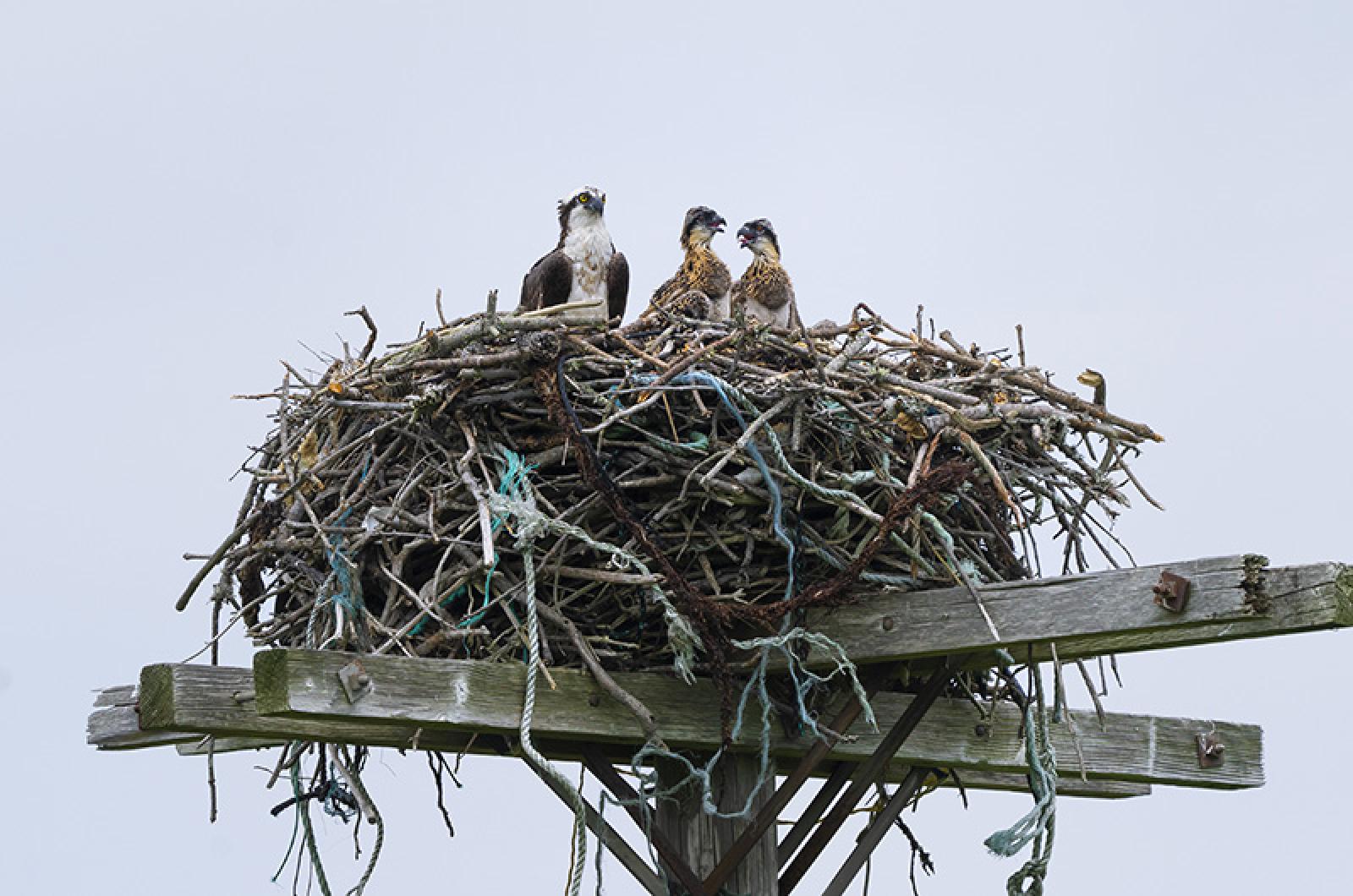A young osprey perched high above the trees at Gus Ben David’s Edgartown home, basking in the late summer sun on a Friday morning. Its parents had already left on their annual migration, and in a few days time the bird would begin its own trek thousands of miles long to South America. Someday the bird will return, find a mate and build a nest of its own on the Vineyard.
Just 50 years ago, a young bird like it would have nowhere to build a home upon its return to Martha’s Vineyard. Island ospreys back then didn’t have nesting locations tailor-made by Mr. Ben David himself.
“It’s been my life, it’s been wonderful,” said Mr. Ben David, sitting in the cabin outside his house overlooking a mosaic of birds and wildlife.
Since 1971, Mr. Ben David has built poles for ospreys to nest and placed them throughout the Island. In just over 50 years, he’s seen 160 poles placed — varying in size and location, but always high above their surroundings.
“The more out in the open, the better they are,” Mr. Ben David said.
In part because of Mr. Ben David’s work stewarding the Island’s osprey population, the bird’s prominence on Martha’s Vineyard has grown by orders of magnitude.
“This is the most we ever had,” said Rob Bierregard, a Drexel University research associate who has studied osprey on the Island since the 1970s.
In a recent phone interview with the Gazette, Mr. Bierregard spoke about this year’s osprey census and the ways the population has changed over the decades.
Mr. Bierregard said he counted 112 breeding osprey nests this summer, exactly twice the count from 2006. He said parents typically have one or two viable offspring when they mate, and some younger ospreys that have not yet nested also spend time on the Island.
“So that’s 400 ospreys plus the teenagers that are floating around,” he said.
Mr. Bierregard started working with osprey on the Vineyard alongside Mr. Ben David in 1971. Back then, there were only two pairs of ospreys nesting on Martha’s Vineyard.
The two nests were home to a relatively high number of eggs at a time when the population in southern New England was suffering from the effects of DDT pesticide use. On the Vineyard, DDT had largely gone out of use in the 1950s, saving the osprey from the adverse effects of the chemical.
“So the osprey didn’t have any of the eggshell thinning problems,” Mr. Bierregard said.
What kept the population from growing on the Vineyard in the 1970s was the ospreys’ limited options for nesting. Favoring high places, the birds would nest in telephone poles and power company workers routinely knocked the nests down.
“Not meaning any harm … It was a utilitarian thing,” Mr. Ben David said. “So you have a static situation because the osprey couldn’t expand — they didn’t have any nests.”
So began Mr. Ben David’s work putting up poles for the ospreys to nest. Dozens of feet tall, the poles have jagged, branching caps to mimic the branches of a pitch pine, one of the birds’ common nesting locations.
Mr. Ben David keeps a record of each pole put up on the Vineyard — its height, location, the folks who helped raise it from the ground. He said he receives constant calls from property owners looking to have a pole placed on their property.
“I’m not the first person that put artificial poles up,” Mr. Ben David said, noting that farmers used to place them to attract ospreys that would ward off red-tail hawks preying on poultry.
With a half-century’s work, Mr. Ben David watched the population grow into the hundreds with little sign of slowing down. He said if something stops ospreys from nesting on the Island it will likely be an outside environmental factor like food availability.
“We plugged in the missing component for the osprey population,” Mr. Ben David said.
Mr. Bierregard said that of the 112 breeding pairs of osprey found this summer, 91 were nested on poles erected specifically for the birds. Mr. Bierregard said if Mr. Ben David hadn’t begun to build poles for osprey nests, the birds would have taken over telephone poles all over the Island.
“The power company would have a whole division of nest knocker-downers,” Mr. Bierregard said.
He said the increase in population won’t have an adverse effect on the environment — the fish they eat are too plentiful for the osprey to put a significant dent in the ecosystem — but the change over the years has brought the birds to a new prominence on the Island.
“I’ve always thought that when the Vineyard finally secedes from the union, the osprey will be the national bird,” Mr. Bierregard said.








Comments (8)
Comments
Comment policy »